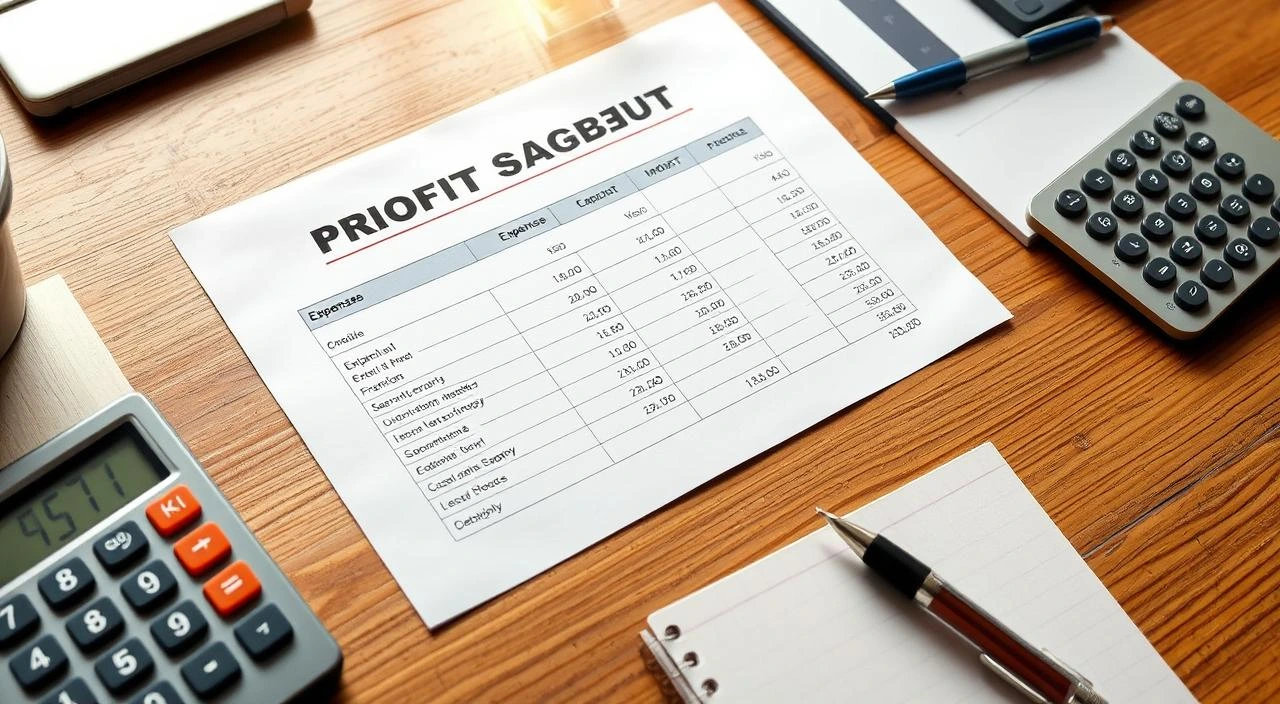An entrepreneur explains a Profit and Loss (P&L) statement is easy: sales minus costs equals profit. It’s a vital tool for small business owners to manage their finances and make informed decisions. Our guide will help you create and understand a profit and loss statement for your business.
Key Takeaways
- A P&L statement shows your business’s income, expenses, and profit over time.
- Small businesses can use software or accountants to make their P&L statements. These can be monthly, quarterly, or yearly.
- Looking at your P&L can help spot gains, losses, trends, and ways to save money. This can boost your business’s finances.
- Comparing your current P&L to past ones can give you insights and a competitive edge.
- Knowing your P&L well is key to making smart business decisions.
Introduction to Profit and Loss Statements
A profit and loss (P&L) statement, also known as an income statement, is key for any business. It shows a company’s income, expenses, and profit or loss over time. This helps small business owners understand their financial health and make smart choices.
What is a Profit and Loss Statement?
The P&L statement gives a detailed look at a business’s money matters. It includes sales, costs, and expenses. This way, owners can see how their business is doing and find ways to improve.
Importance of P&L Statements for Small Businesses
For small businesses, the P&L statement is vital. It helps owners make smart choices and keep their business healthy. By checking the P&L often, owners can:
- Keep an eye on income and expenses to stay profitable
- Find ways to save money and get better
- Decide on prices, products, and marketing
- Plan for the future and grow
- Show lenders or investors they’re stable
Using either the cash or accrual method, the P&L statement gives a full picture of a small business’s finances. It helps owners make informed decisions and grow their business.
How to Create a Profit and Loss Statement
Creating a detailed profit and loss (P&L) statement is key for small business owners. It shows your company’s income, costs, and profit. Knowing how to make a P&L helps you understand your business better and make smart choices for growth.
Step 1: Calculate Revenue
To start a P&L, figure out your total revenue. This is the money your business made from selling things or services. Just add up all the money from sales, fees, and other income.
Step 2: Calculate Cost of Goods Sold
Then, find out the cost of goods sold (COGS). This includes direct costs like raw materials, labor, and other production or delivery expenses. Subtracting COGS from revenue gives you your gross profit.
Step 3: Calculate Gross Profit
Gross profit is what’s left after covering direct costs. It shows how much money you have to pay for other expenses and make a profit. Knowing your gross profit helps you see how profitable your business is and where to improve.
“Understanding your gross profit margin is essential for making informed business decisions and driving long-term success.”
Operating Expenses and Profit Calculations
After finding your gross profit, the next step is to include your operating expenses. These are indirect costs like rent, utilities, and payroll. Subtracting these from your gross profit gives you your operating profit. This shows how profitable your main business activities are.
Step 4: Calculate Operating Expenses
Operating expenses are the usual costs of running a business. They can be broken down into several types:
- Administrative expenses: Office supplies, telecommunications, insurance, and other administrative costs
- Marketing and advertising expenses: Costs for promoting your products or services
- Payroll and employee-related expenses: Salaries, benefits, and other employee costs
- Rent and utilities: Rent and bills for electricity, water, and more
- Depreciation and amortization: The decrease in value of your assets over time
Step 5: Calculate Operating Profit
First, find your total operating expenses. Then, subtract these from your gross profit. This will give you your operating profit. It shows how well your main business activities are doing.
The formula for calculating operating profit is:
Gross Profit – Operating Expenses = Operating Profit
By watching your operating expenses and profit, you can find ways to make your business more efficient and profitable.
Additional Income and EBITDA
When figuring out your small business’s profit, think about extra money you make. This could be from savings interest, investment dividends, or other extra money. Adding these to your main profit gives you a better look at earnings before interest, taxes, depreciation, and amortization (EBITDA).
EBITDA shows how well your business is doing overall. It looks at your profit before money matters and accounting tricks. This helps you see how efficient your business is. It’s great for checking how your business is doing compared to others in your field.
| Metric | Terracotta Warriors Inc. | Pot Barn Inc. |
|---|---|---|
| Sales Revenue | $57,050.68 | $57,833.72 |
| Operating Earnings | $21,016.34 | $21,052.44 |
| Additional Income | $5,000.00 | $4,477.34 |
| EBITDA | $26,016.34 | $25,529.78 |
Adding extra income to your profit gives a clearer view of your business’s health. This information is vital for making big decisions, getting loans, or planning to grow.
Interest, Taxes, Depreciation, and Amortization
To complete your profit and loss statement, you must include interest, taxes, depreciation, and amortization. These are subtracted from your EBITDA (Earnings Before Interest, Taxes, Depreciation, and Amortization). This shows your net profit or loss, which is your business’s final result.
Calculating Interest, Taxes, Depreciation, and Amortization
Start by subtracting any interest payments on loans or financing. Then, add any taxes owed to governments. Remember to include depreciation and amortization. These reduce the value of your assets over time.
For example, a spa makes $25,000 a month but spends $10,000 on COGS. This leaves a gross profit of $15,000. After operating expenses, the EBITDA is $8,000. But, the spa also pays $500 in interest, $17.85 in depreciation, and $33.33 in amortization. So, the net profit is $7,448.82 ($8,000 – $500 – $17.85 – $33.33).
By correctly figuring out interest, taxes, depreciation, and amortization, you can find your business’s real net profit or loss. This is key to knowing your financial health and making smart choices.
Profit and Loss Statement for Small Business
A profit and loss statement for a small business shows its financial health. It lists total income, costs, and profits. This helps you understand if your business is making money and its financial health.
Step 8: Calculate Net Profit
The last step is to figure out your net profit. This is the key number that shows if your business is profitable. To find it, subtract all your expenses from your total income.
Let’s look at an example using data from two small businesses:
| Metric | Terracotta Warriors Inc. | The Pot Barn Inc. |
|---|---|---|
| Total Revenues | $57,050.68 | $62,311.06 |
| Cost of Goods Sold | $24,984.79 | N/A |
| Gross Profit | $32,065.89 | N/A |
| Operating Expenses | $11,049.55 | $51,411.37 |
| Operating Profit | $21,016.34 | N/A |
| Interest Expense | $5,000.00 | N/A |
| Earnings Before Income Tax | $16,016.34 | N/A |
| Income Tax Expense | $10,000.00 | N/A |
| Net Profit | $6,016.34 | $10,899.69 |
Knowing your net profit shows how well your business is doing financially. It helps you make choices to increase profits.
Understanding Your P&L Statement
Analyzing your profit and loss (P&L) statement gives you important insights. It shows which products and services are most profitable. This helps you decide what to offer.
Looking at past P&L statements shows trends in your business. You might see changes in revenue, expenses, and profits. This information helps you make better decisions to grow your business financially.
Product and Service Profitability
The P&L statement breaks down your income, showing which products and services are most profitable. By looking at costs and margins, you can see which items are most efficient. This helps you set prices, manage inventory, and market better to boost profits.
Business Trends and Trajectory
Reviewing P&L statements over time reveals trends in your business. You might see revenue going up or down, or expenses changing. These trends help you understand seasonal patterns, new initiatives’ impact, and market changes.
This knowledge is key for planning your business’s future. It helps you adjust strategies to stay on track financially.
| Month | Sales | Gross Profit | Net Income | Profit Margin |
|---|---|---|---|---|
| April | $5,000 | $2,477 | $2,477 | 49.54% |
| May | $6,500 | $3,225 | $3,225 | 49.62% |
| June | $8,000 | $3,963 | $3,963 | 49.54% |
The table shows a lemonade stand’s financial performance over three months. It highlights the highest profitability in June. This suggests seasonality, helping the owner make informed decisions to improve financial performance.
Best Accounting Software for P&L Statements
Small businesses need to understand their finances well. Accurate profit and loss (P&L) statements are key. Accounting software like QuickBooks Desktop, FreshBooks, and OneUp make this easier.
QuickBooks Desktop
QuickBooks Desktop is great for small to medium-sized businesses. It has a 4.5 out of 5 user rating. It’s known for its strong financial reporting and easy P&L statement creation.
FreshBooks
FreshBooks is cloud-based and perfect for very small businesses. It also has a 4.5 out of 5 rating. It’s easy to use and has features like invoicing and expense tracking.
OneUp
OneUp is another top choice for small businesses. It offers detailed financial management tools, including P&L statements. Its dashboard is user-friendly, helping you make better financial decisions.
These accounting software solutions help small businesses create and analyze P&L statements easily. This leads to better decision-making and financial success.
Benefits of Regular P&L Statement Analysis
Checking your profit and loss statement regularly is very helpful. It shows how much money you make, spend, and keep. This helps you spot areas for improvement and make smart choices.
Regularly reviewing your P&L helps you see what’s working and what’s not. For example, if costs are too high, you can try to lower them. If sales drop, you can adjust your marketing or look for new opportunities.
Understanding your P&L well helps you make better decisions. By watching your income, expenses, and profits over time, you can predict future needs. This is useful when you need more money or want to change your prices.
Keeping an eye on your P&L is essential for understanding your business’s health. By looking at your net profit, you can ensure your business is growing well. This helps you plan for the future and keep your business on track.
In short, regularly checking your P&L statement is very beneficial. It helps you set the right prices, manage costs, make smart choices, and keep an eye on your business’s health. By using this financial information, you can strengthen your business and achieve your growth goals.
Outsourcing Financial Expertise
As a small business owner, you might not have the time or skills for all accounting and bookkeeping. Outsourcing these tasks to a professional like CFO Hub can be a smart move. This way, you get accurate profit and loss statements and insights for better business decisions.
Outsourcing financial services has many benefits for small businesses. A study found 63% of owners underestimate payroll processing time, showing the need for help. It can also cut costs like office space and employee benefits. Working with a firm like Near means you get a team of finance pros who meet high standards.
Networking events and LinkedIn can help find the right accounting service providers. They offer the expertise and knowledge for accurate financial management. This can save you money by only paying for what you need, without extra costs for in-house staff.
Outsourcing also means your business can grow and change more easily. You can adjust accounting services without the hassle of hiring or firing. Plus, you get faster and more reliable financial data for better decision-making and growth.
“Outsourcing accounting services for small businesses can lead to substantial cost savings by paying only for the services needed, minimizing additional expenses such as salaries, benefits, and training for in-house accountants.”
Using professional accounting and financial services can really help small businesses. By outsourcing, you can focus on your main business while getting the financial expertise you need. This can drive your company’s success.
Conclusion
The profit and loss statement guide is key for small businesses. It helps us understand our revenue, expenses, and profitability. This knowledge guides our decisions and helps us grow.
Preparing P&L statements can be done in-house or with financial professionals. Regularly reviewing them is key for success. It helps us manage finances better and make informed decisions.
The profit and loss statement is essential for small business management. It helps us see our financial health and find ways to improve. By using this report, we can ensure our business thrives in the future.
FAQ
What is a profit and loss statement?
A profit and loss (P&L) statement shows a company’s income, expenses, and profit or loss over time. It helps business owners see how well their business is doing. This includes tracking income, expenses, and profit.
Why is a profit and loss statement important for small businesses?
For small businesses, a P&L statement is key to knowing the company’s financial health. It helps spot areas to improve and guides growth decisions. It shows how profitable your business is and its overall financial state.
How do I create a profit and loss statement?
To make a profit and loss statement, you need to add up your total income. Then, figure out the cost of goods sold and operating expenses. Lastly, calculate your net profit or loss. Accounting software can make this easier.
How can I analyze my profit and loss statement?
By analyzing your profit and loss statement, you can see how profitable each product or service is. You can also spot trends in income, expenses, and profit. This info helps you make smart business choices.
What are the benefits of regularly reviewing my profit and loss statement?
Reviewing your profit and loss statement often helps you set better prices and control costs. It ensures your business grows sustainably. It also guides your strategic decisions and finds ways to save money and grow.
Should I outsource the preparation of my profit and loss statements?
As a small business owner, you might not have time or know-how for all accounting tasks. Outsourcing to a financial services provider can be a smart move. It keeps your statements accurate and up-to-date, helping you make better business choices.

My name is Jakir, I am a content writer, content creator, I give business, sports, finance, trending news and I have 10 years of experience in this and this is my blog goldennews24.com.










